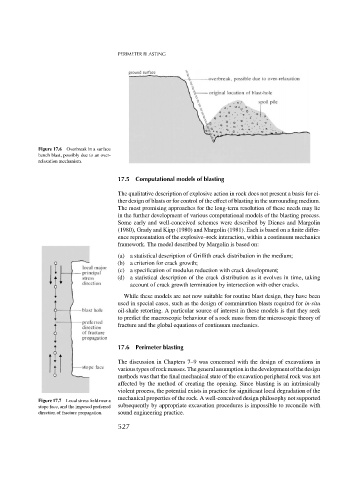Page 545 - Rock Mechanics For Underground Mining
P. 545
PERIMETER BLASTING
Figure 17.6 Overbreak in a surface
bench blast, possibly due to an over-
relaxation mechanism.
17.5 Computational models of blasting
The qualitative description of explosive action in rock does not present a basis for ei-
ther design of blasts or for control of the effect of blasting in the surrounding medium.
The most promising approaches for the long-term resolution of these needs may lie
in the further development of various computational models of the blasting process.
Some early and well-conceived schemes were described by Dienes and Margolin
(1980), Grady and Kipp (1980) and Margolin (1981). Each is based on a finite differ-
ence representation of the explosive–rock interaction, within a continuum mechanics
framework. The model described by Margolin is based on:
(a) a statistical description of Griffith crack distribution in the medium;
(b) a criterion for crack growth;
(c) a specification of modulus reduction with crack development;
(d) a statistical description of the crack distribution as it evolves in time, taking
account of crack growth termination by intersection with other cracks.
While these models are not now suitable for routine blast design, they have been
used in special cases, such as the design of comminution blasts required for in-situ
oil-shale retorting. A particular source of interest in these models is that they seek
to predict the macroscopic behaviour of a rock mass from the microscopic theory of
fracture and the global equations of continuum mechanics.
17.6 Perimeter blasting
The discussion in Chapters 7–9 was concerned with the design of excavations in
various types of rock masses. The general assumption in the development of the design
methods was that the final mechanical state of the excavation peripheral rock was not
affected by the method of creating the opening. Since blasting is an intrinsically
violent process, the potential exists in practice for significant local degradation of the
mechanical properties of the rock. A well-conceived design philosophy not supported
Figure 17.7 Local stress field near a
stope face, and the imposed preferred subsequently by appropriate excavation procedures is impossible to reconcile with
direction of fracture propagation. sound engineering practice.
527

